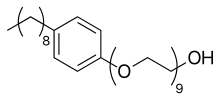Nonoxynol-9
Nonoxynol-9, sometimes abbreviated as N-9, is an organic compound that is used as a surfactant. It is a member of the nonoxynol family of nonionic surfactants. N-9 and related compounds are ingredients in various cleaning and cosmetic products. It is widely used in contraceptives for its spermicidal properties.
 | |
 | |
| Names | |
|---|---|
| IUPAC name
2-{2-[2-(2-{2-[2-(2-{2-[2-(4-Nonylphenoxy)ethoxy]ethoxy}ethoxy)ethoxy]ethoxy}ethoxy)ethoxy]ethoxy}ethanol | |
| Preferred IUPAC name
26-(4-Nonylphenoxy)-3,6,9,12,15,18,21,24-octaoxahexacosan-1-ol[1] | |
| Other names
1-(4-Nonylphenyl)-1,4,7,10,13,16,19,22,25-nonaoxaheptacosan-27-ol | |
| Identifiers | |
3D model (JSmol) |
|
| 2031786 | |
| ChEBI | |
| ChEMBL | |
| ChemSpider | |
| DrugBank | |
| ECHA InfoCard | 100.043.454 |
| EC Number |
|
| KEGG | |
| MeSH | Nonoxynol |
PubChem CID |
|
| UNII | |
CompTox Dashboard (EPA) |
|
| |
| |
| Properties | |
| C33H60O10 | |
| Molar mass | 616.833 g·mol−1 |
| log P | 4.02 |
| Pharmacology | |
| Topical | |
Except where otherwise noted, data are given for materials in their standard state (at 25 °C [77 °F], 100 kPa). | |
| Infobox references | |
Uses
Spermicide
As a spermicide, it attacks the acrosomal membranes of the sperm, causing the sperm to be immobilized. Nonoxynol-9 is the active ingredient in most spermicidal creams, jellies, foams, gel, film, and suppositories.
A 2004 study found that over a six-month period, the typical-use failure rates for five nonoxynol-9 vaginal contraceptives (film, suppository, and gels at three different concentrations) ranged from 10% to 20%.[2]
Condoms
Many models of condoms are lubricated with solutions containing nonoxynol-9. In this role, it has been promoted as a backup method for avoiding pregnancy and a microbicide for sexually transmitted diseases in the event of condom failure. However, the 2001 WHO / CONRAD Technical Consultation on Nonoxynol-9 concluded that: There is no published scientific evidence that N-9-lubricated condoms provide any additional protection against pregnancy or STDs compared with condoms lubricated with other products. Since adverse effects due to the addition of N-9 to condoms cannot be excluded, such condoms should no longer be promoted. However, it is better to use N-9-lubricated condoms than no condoms.[3]
Compared to regular lubricated condoms, condoms containing nonoxynol-9 present another disadvantage — they have a shorter shelf life.
Cervical barriers
Almost all brands of diaphragm jelly contain nonoxynol-9 as the active ingredient. This jelly may also be used for a cervical cap. Most contraceptive sponges contain nonoxynol-9 as an active ingredient.
Shaving cream
Nonoxynol-9 is sometimes included in shaving creams for its properties as a nonionic surfactant; it helps break down skin oils that normally protect hair from moisture, so that they become wet and, hence, softer and easier to shave. Gillette formerly used nonoxynol-9 for this purpose in its Foamy products, but has discontinued the practice.
Sports cream
Nonoxynol-9 is also found in Bengay Vanishing Scent as an inactive ingredient.
Poison ivy creams
Nonoxynol-9 is also found in Zanfel poison ivy cream. It effectively helps to break up the oil urushiol that causes the rash.
Side effects
From 1996 to 2000, a UN-sponsored study conducted in several locations in Africa followed nearly 1,000 sex workers who used nonoxynol-9 gels or a placebo. The HIV infection rate among those using nonoxynol-9 was about 50% higher than those who used the placebo; those using nonoxynol-9 also had a higher incidence of vaginal lesions, which may have contributed to this increased risk. Whereas these results may not be directly applicable to lower-frequency use, these findings combined with lack of any demonstrated HIV-prevention benefit from nonoxynol-9 use led the World Health Organization to recommend that it no longer be used by those at high risk of HIV infection. The WHO further notes that "Nonoxynol-9 offers no protection against sexually transmitted infections such as gonorrhoea, chlamydia."[3] A 2006 study of a nonoxynol-9 vaginal gel in female sex workers in Africa concluded that it did not prevent genital human papillomavirus (HPV) infection and could increase the virus's ability to infect or persist.[4]
References
- IUPAC Chemical Nomenclature and Structure Representation Division (2013). "P-51.4.1". In Favre, Henri A.; Powell, Warren H. (eds.). Nomenclature of Organic Chemistry: IUPAC Recommendations and Preferred Names 2013. IUPAC–RSC. ISBN 978-0-85404-182-4.
- Raymond, Elizabeth G.; Lien Chen, Pai; Luoto, Joanne; for the Spermicide Trial Group (March 2004). "Contraceptive effectiveness and safety of five nonoxynol-9 spermicides: a randomized trial". Obstetrics & Gynecology. 103 (3): 430–439. doi:10.1097/01.AOG.0000113620.18395.0b. PMID 14990402.
- Siegfried, Nandi (September 25, 2003). "Nonoxynol-9 for preventing vaginal acquisition of HIV infection by women from men". Reproductive Health Library. Geneva: World Health Organization. Retrieved February 21, 2010.
- Marais, Dianne; Carrara, Henri; Kay, Patti; Ramjee, Gita; Allan, Bruce; Williamson, Anna-Lise (November 2006). "The impact of the use of COL-1492, a nonoxynol-9 vaginal gel, on the presence of cervical human papillomavirus in female sex workers". Virus Research. 121 (2): 220–222. doi:10.1016/j.virusres.2006.04.009. PMID 16860426.
External links
- Safety of Nonoxynol-9 when used for contraception World Health Organization (October 2001)
- Vaginal Spermicide: Nonoxynol Family Practice Notebook.com
- Docs: 'Nonoxynol-9 Doesn't Work' Wired News: Lite, Jordan (May 13, 2002)
- Info on microbicides
- ChemSub Online: Nonoxynol-9
- Record in the Household Products Database of NLM